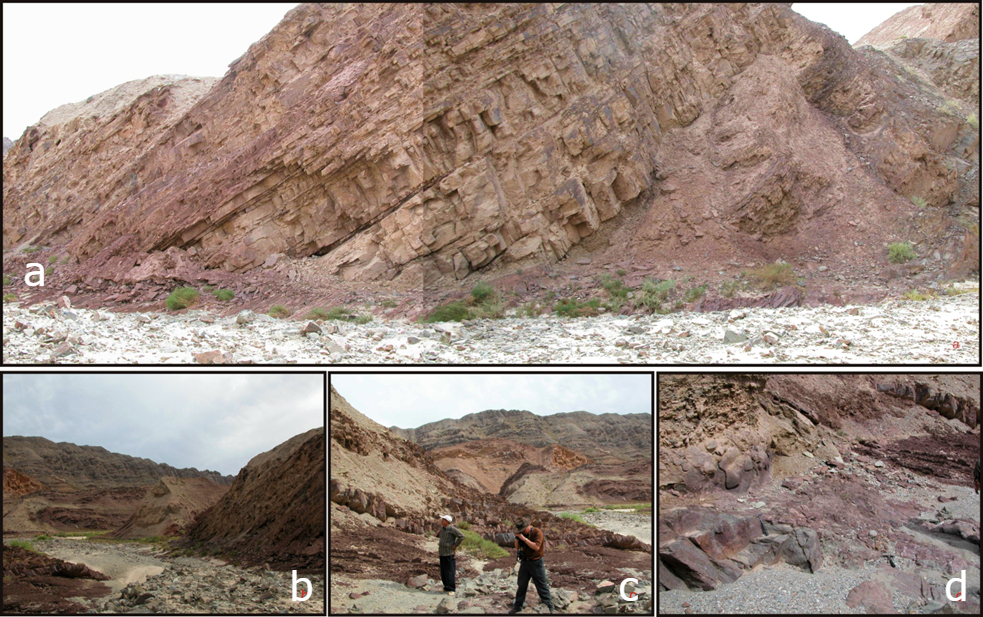Sugetbulak Fm
Type Locality and Naming
Aksu-Kalpin region. The name Sugetbulak Fm is derived from the Sugetbulak Bed named by V. M. Sinitsyn in 1957. The typical section (E79°17′30″; N40°50′00″) is situated in Sugetbulak (spring) in the northwest of Aksu City, and the reference section is 4 km west of Yourmeinak village, Xinjiang Weiwuerzhu Zizhiqu (Xinjiang Uygur Autonomous Region). Synonym: Sugaitbulak Fm (an alternative English spelling). Middle formation of the Wushinanshan Gr.
The Suget layer, named in Xini Village in 1952, includes this formation and the overlying, Qigebulak Fm, Xiaoerbulake Fm, Yuertusi Fm, Awatag Fm and other formations. (later, people aften confused The Suget layer with the Bulaque Formation in Sugai). In 1957, Zhang Zhenhua, Gao Zhenjia and others re-subdivided and defined the lower red sandstone and named it the Sugaiteobulake Fm, which is still in use today.
Synonym: (苏盖特布拉克组), Sugaiteobulake Fm
[Figure: The Sugetbulak Formation in Aksu area, Xinjiang. a-The section of the Sugetbulak Fm; b,c-The lower part of the Sugetbulak Fm; d-The boundary between the Sugetbulak Fm and the Aksu Gr.]
Lithology and Thickness
Based on the sedimentary characteristics, the Sugetbulak Fm is subdivided into two subformations. The Lower Subformation is detrital sediments deposited in the intertidal zone of strongly oxidizing marine environment, and it includes three parts. The Lower part is dominated by variegated (purple-red, brown-red, minor gray-green and yellow-green) thin- to medium-bedded ferruginous feldspathic litharenite and lithic sandstone, intercalated with red purple thick-bedded coarse-grained lithic sandstone. The basal part is coarse-grained pebbly grit (with well-developed tidal beddings such as herringbone bedding and bidirectional crossbedding). The Middle part is greenish gray to red purple fine-grained feldspathic quartzose sandstone intercalated with siltstone and silty mudstone with small asymmetric ripple marks. The Upper part consists of red purple to brown red minor gray coarse-grained quartzose sandstone, ferruginous sandstone, feldspathic quartzose sandstone and minor siltstone and silty mudstone bearing minor glauconite (locally enriched into micro-bandings) and well-rounded clasts, with commonly herringbone cross-bedded. In addition, this subformation bears intercalations or lenses of trachy-basalt, olivine basalt, tuffaceous sandstone and volcanic breccia. The Upper Subformation is composed of carbonate rock to fine-clastic rock. Its Lower part is dominated by red purple thin-bedded sandy limestone interbedded with light green calcareous sandstone. Its Middle part, glauconitic siltstone, limestone, detrital limestone and edgewise limestone intercalated with calcareous sandstone with hummocky beddings. Its Upper part is greenish yellow to yellowish brown glauconitic feldspathic sandstone intercalated with calcareous sandstone with micro cross-beddings. With a persistent lithology, the thickness generally varies from 580 to 888 m, and near the old upwelling area, it thins to about 200 m.
Relationships and Distribution
Lower contact
The Sugetbulak Fm unconformably overlies the underlying tillite or the Qiaoenbulak Fm, or overlays strata older than the Aksu Gr if the tillite is lacking.
Upper contact
The top is conformably overlain by the Qigbulak Fm
Regional extent
Aksu-Kalpin region. The Sugetbulak Formation is distributed between Aksu (to Kalpin) and Wushi in the northwest fringe of the Tarim Basin, and eastward to the Xiaotielie area north of Baicheng County.
GeoJSON
Fossils
The Sugetbulak Fm yields abundant microplants Leiopsophosphaera pussilla, Trachysphaeridium rugosum, T. hyalinum, T. incrassatum, T. medium, T. stipticum, Pseudofauospsphaera kepingensis, Hubeisphaera sp., Laminarites antiquissimus etc., and trace fossils (in sandstone) Chondrites etc.
Age
Depositional setting
Clastic shelf (lower subformation is intertidal; upper subformation has storm beds)
Additional Information
A U-Pb whole rock date of 740 Ma (mean value) is acquired from the red sandstone (Zhu Zhenjie et al., 1987). A paleomagnetic study revealed four reversals of the paleomagnetic pole.
